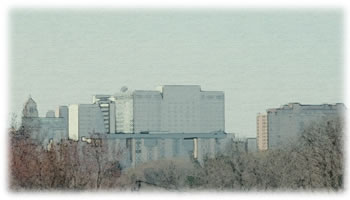 |
|
After a fibrosarcoma was incompletely removed from just above Tom's left eye, we sought treatment at the Mayo Clinic, Rochester, MN. Here, Tom received a CAT scan of his torso and head, and an MRI of his head. We then met with Dr. James Garrity. The CAT scan showed no indication that the tumor had metastasized to Tom's lungs or abdomen (the usual places sarcomas spread.) The MRI gave no clear evidence that the tumor had been entirely removed. Dr. Garrity informed us that Tom was the 10th person in ten years to be diagnosed with this type of cancer in this location. Fibrosarcomas are aggressive and do not respond well to chemotherapy or radiation therapy. Dr. Garrity recommended that all soft tissue in Tom's left orbital area be removed. I cried when I heard the news. I had tried so hard to keep this from happening and felt as though I had failed. Dr. Garrity's nurse was most supportive during this time, for which we will always be grateful. We were then given an option that would not have been possible had the local ophthalmologist performed the surgery. Tom would undergo three operations that would eventually allow him to be fitted with a prosthesis instead of being left with a large gaping hole in the left side of his face. Further, Tom's cornea could be donated because there is no blood exchange to the cornea. These were two rays of light in the darkness. At the time of Tom's original diagnosis, we had requested that tissue samples be sent to Dr. Evans at the University of Texas MD Anderson Cancer Center for a second opinion, but we didn't allow much time for him to complete his testing. Just prior to Tom's first surgery at Mayo, we received the news that the second opinion concurred with the original diagnosis. Once the surgeries were over, Tom would be closely monitored, but would not receive any other form of treatment. |